Different Color Gems Silver Jewelry Picture
Home » Gemstones » Colored Stone Pictures
Photos of Colored Stones
The term "colored stone" refers to any species of gem, other than diamond.
(An exception is colored diamonds - they are considered to be colored stones.)
Author: , PhD, GIA Graduate Gemologist
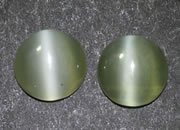 | Actinolite (Cat's-Eye)Actinolite is green to grayish green mineral of the amphibole group found in metamorphic rocks. It sometimes has a fibrous texture that produces a strong cat's-eye. |
| | |
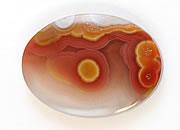 | AgateAgate is a cryptocrystalline quartz that is translucent and patterned with bands, plumes, dendrites, or inclusions that produce a colorful, interesting appearance. It is a popular gem cut into cabochons, beads, and ornamental objects. |
| | |
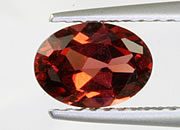 | Almandine GarnetAlmandine garnet, also known as "almandite," is an iron-rich, red-to-purple garnet that is geologically very common and typically sells on the more affordable side of the garnet price range. For that reason, it is common in jewelry. |
| | |
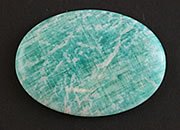 | AmazoniteAmazonite is a trade name given to a light green to bright green variety of microcline feldspar. It has a Mohs hardness of 6 with perfect cleavage, so it is best used where it will not suffer abrasion or impact. |
| | |
 | AmberAmber is a fossil resin secreted by ancient trees. It usually has a yellowish to orangish brown color but can be white, greenish, bluish, or black. It is an organic gem easily cut and polished into bright, lightweight gems. |
| | |
 | AmethystAmethyst is a transparent variety of quartz that ranges from light lilac to deep purple in color. It is one of the most popular faceted gemstones and is sometimes cut en cabochon. It is found in many locations around the world. |
| | |
 | AmetrineAmetrine is a bicolor quartz that is half AMEthyst and half ciTRINE. The color combination is caused by twinning. It is commercially produced at only one mine in the world, located in eastern Bolivia. |
| | |
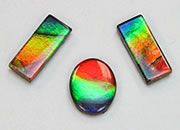 | AmmoliteAmmolite is a trade name used for iridescent ammonite shell. It produces a bright flash of color that rivals opal and labradorite. All of the world's production of this organic gem is from a small area in Alberta, Canada. |
| | |
 | AmmoniteAn extinct group of marine invertebrate animals that produced a chambered shell. Their fossilized shells are often cut and used as organic gems. |
| | |
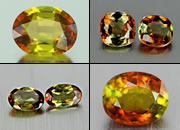 | AndalusiteAndalusite is a metamorphic mineral that is strongly pleochroic and an underappreciated gem. A variety known as chiastolite has grains of graphite concentrated into a cross-shaped feature. |
| | |
| ADVERTISEMENT | |
| | |
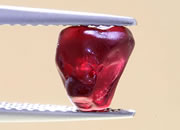 | Ant Hill GarnetAnt hill garnet is a novelty gem that ants excavate, haul to the surface and deposit on their ant hill. These red chrome pyrope garnets are often found on ant hills in parts of the southwestern USA. |
| | |
 | ApatiteApatite is a mineral that is cut as a gem when found in clear crystals with attractive colors. It has a hardness of 5 on the Mohs scale and is brittle. It is a "collector's gem" rather than a jewelry gem. |
| | |
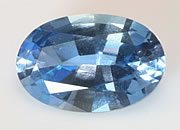 | AquamarineAquamarine is a blue variety of the mineral beryl. It receives its name from its seawater color. It ranges from a very light blue to a richly saturated blue. The richer color is much more desired. |
| | |
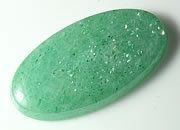 | AventurineAventurine is a quartz variety that contains a blizzard of tiny reflective inclusions such as muscovite, hematite, or fuchsite. Light enters the stone, reflects from the grains and produces a flash known as aventurescence. |
| | |
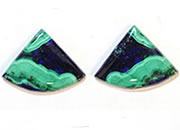 | AzuriteA beautiful dark blue opaque gem material found near copper deposits. Associated with malachite and chrysocolla; soft (H: 3.5-4); cleaves easily. Best used as cabochons in jewelry that will not encounter wear. |
| | |
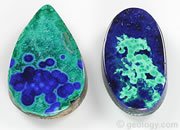 | AzurmalachiteA beautiful blue and green gem material that is a combination of the copper minerals, azurite and malachite. It is soft and chips easily. It is cut into cabochons for use in jewelry that will not encounter wear. |
| | |
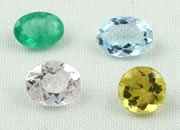 | Beryl"Beryl" is a mineral with several gem varieties based upon color. Green beryl is emerald. Blue is aquamarine. Pink is morganite. Yellow and yellow-green are heliodor. Red is red beryl. Clear is goshenite. |
| | |
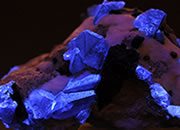 | Benitoite"Benitoite" is a rare barium titanium silicate mineral found at a few locations worldwide but in gem quality at only in one location in San Benito County, California. It is the "state gem" of California. |
| | |
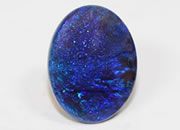 | Black OpalThe name "black opal" is used for an opal with a black base color. This specimen here has blue play-of-color on a black base. |
| | |
 | BloodstoneBloodstone is a dark green variety of jasper that displays numerous splashes of red color. These red splashes remind people of blood, and that is how the stone received its name. It has been a popular gem for thousands of years. |
| | |
 | Boulder Opal"Boulder opal" is a name used for a rough or cut rock material that displays precious opal within its surrounding rock matrix. |
| | |
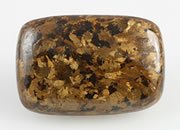 | BronziteA bronze to greenish variety of enstatite with a metallic luster. It is sometimes cut and polished as a gemstone. |
| | |
 | BumblebeeOften called Bumblebee "Agate" or "Jasper," it is instead a rock formed at several volcanic vents in Indonesia. Some specimens reportedly contain arsenic. Not recommended if the stone will be in direct contact with your skin. |
| | |
 | ChalcedonyChalcedony is a name used for any cryptocrystalline quartz such as agate, jasper, petrified wood, chrysoprase, bloodstone, onyx, sard, and carnelian. Some people reserve the name for a blue, unbanded, translucent material. |
| | |
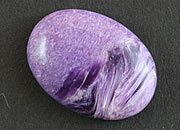 | CharoiteCharoite is a light lavender to deep purple silicate mineral that has swirling, fibrous, or spotted patterns. It is a rare and relatively new gem material, discovered in Russia in 1978. |
| | |
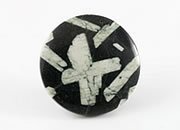 | Chinese Writing StoneA very interesting black metamorphosed limestone that contains geometric crystals of andalusite. Named because the intersecting white crystal shapes remind some people of "Chinese writing." |
| | |
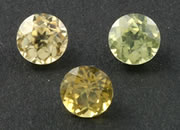 | ChrysoberylChrysoberyl, a gem unrelated to "beryl," is an "extreme gem." It has a hardness of 8.5, a very high luster, and a high index of refraction. It is sometimes a color-change stone and is best known for its "cat's-eye." |
| | |
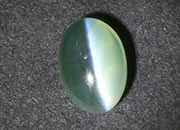 | Chrysoberyl Cat's-EyeChrysoberyl often contains oriented inclusions that produce a sharp line of light across the surface of the stone in reflected light. This optical phenomenon is known as a "cat's-eye." |
| | |
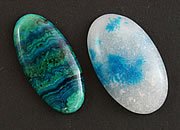 | ChrysocollaChrysocolla is a green to blue-green gem material that forms during the oxidation of copper deposits. The cab on the left is malachite with chrysocolla. The cab on the right is blue chrysocolla in white quartz. |
| | |
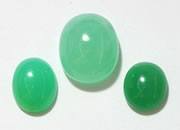 | ChrysopraseChrysoprase is a yellowish green to bright green variety of chalcedony that is thought to obtain its color from small amounts of nickel. It is a color-variety of cryptocrystalline quartz. |
| | |
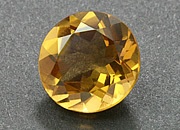 | CitrineCitrine is a transparent variety of quartz that ranges from golden yellow to yellowish orange to golden brown in color. It is usually cut as a faceted stone and is sometimes produced by heat treating amethyst. |
| | |
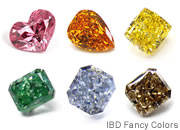 | Colored DiamondsColored diamonds are diamonds that have a noticeable bodycolor when viewed in the face-up position. Gems with superb color can fetch extraordinary prices, often over $1 million per carat. |
| | |
 | Common OpalCommon opal is an opal material that does not exhibit a "play-of-color." Most common opal is common in appearance, but some is spectacular in color or pattern. |
| | |
| ADVERTISEMENT | |
| | |
 | CoralCoral is a colonial organism that lives in warm, shallow marine waters and often develops reefs. It is a hard calcium carbonate material that can be cut or carved and polished into beautiful organic gems. |
| | |
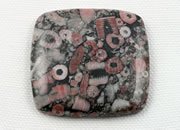 | Crinoidal LimestoneCrinoids are organisms that once lived on the ocean floor. They looked like a plant but were actually an invertebrate animal. Their fossils can be found in limestone that can often be used to produce interesting gems. |
| | |
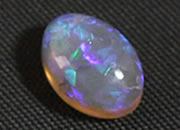 | Crystal OpalCrystal opal is a term used for transparent-to-translucent opal material that has a play-of-color within the stone. |
| | |
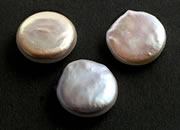 | Cultured PearlsCultured pearls are produced by placing small "seeds" of shell material within a live freshwater mussel. The mussel coats the seed with successive layers of nacre to form a pearl. They are produced in a variety of shapes. |
| | |
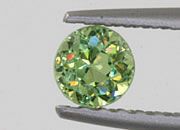 | Demantoid GarnetDemantoid is a calcium-rich garnet. It has the highest dispersion (ability to separate white light into colors of the spectrum) of any gemstone - higher than diamond. This gives demantoid an exceptional "fire." |
| | |
 | DiamondThe most popular gemstone and hardest natural material. A nearly colorless diamond is set in most engagement rings sold in the United States. The custom of giving an engagement diamond is spreading to other countries. |
| | |
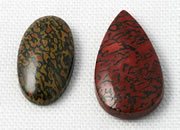 | Dinosaur BoneDinosaur bone is often petrified (fossilized by being infilled and replaced by quartz). The quartz can be very colorful. When the petrification is thorough, the material can be cut and polished into attractive gems. |
| | |
 | DiopsideDiopside is a magnesium, calcium silicate mineral. It often contains traces of chromium that cause a vivid green color. These stones are known as "chrome diopside" and can serve as an alternative gem for emerald. |
| | |
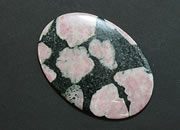 | DioriteDiorite is an igneous rock that can accept a bright polish. It is usually a mixture of dark and light-colored minerals. When these are of attractive colors, the rock can be cut into nice cabochons, beads, and other lapidary items. |
| | |
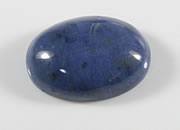 | DumortieriteDumortierite is a dark blue to dark greenish-blue mineral found in metamorphic rocks. It is typically opaque and used to produce cabochons, beads, and tumbled stones. |
| | |
 | EmeraldEmerald is the gemstone name of the mineral beryl when it has a rich green color. It is the most popular stone from the beryl mineral group. Most emeralds have abundant inclusions and fractures. |
| | |
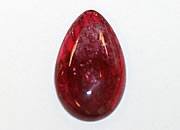 | EudialyteEudialyte is a rare mineral found in igneous rocks. It serves as a minor ore of zirconium and as a minor gem mineral. It occurs in yellow, brown, and bluish crystals - but bright red specimens are favored as a collector's gem. |
| | |
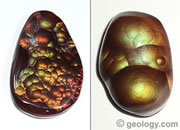 | Fire AgateFire agate is a rare gemstone which exhibits a warm iridescence on its botryoidal surfaces. The specimens shown here are from Arizona - one of the few locations in the world where fire agate has been found. |
| | |
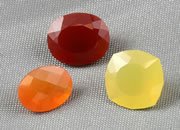 | Fire OpalA translucent-to-transparent opal with a warm background color of yellow, orange, or red. It may or may not exhibit a "play-of-color." The warm, uniform background color is what defines the stone. |
| | |
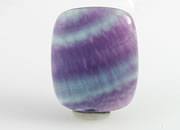 | FluoriteA mineral composed of calcium and fluorine (CaF2) that can be colorful and attractive and is often cut as a gemstone. |
| | |
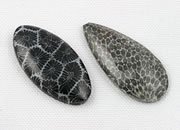 | Fossil OrganismsCoral and bryozoans are organisms that live in warm, shallow marine waters. They are often fossilized by being infilled and replaced with quartz or calcite. These materials can be polished into attractive gems. |
| | |
| ADVERTISEMENT | |
| | |
 | GaspeiteGaspeite is a bright green gem that has become a popular addition to Southwestern-style jewelry, especially as an inlay material. It is also a rare nickel carbonate mineral. |
| | |
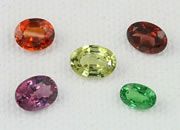 | GarnetGarnet is the name of a group of minerals with a common crystal structure, but variable composition. Most garnets are red, but the stone also occurs in orange, yellow, purple, green, pink, black, and other colors. |
| | |
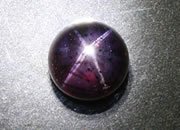 | Garnet (Star)Rare specimens of garnet contain a rutile silk that gives them a four- or six-ray star when cut properly. They are highly valued and have been mined commercially only in Idaho, India, and Madagascar. |
| | |
 | Gem SilicaGem silica is a rare variety of chalcedony that is colored bluish green by tiny inclusions of chrysocolla or copper salts. It is the most valuable variety of chalcedony. |
| | |
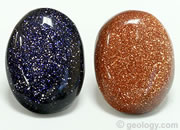 | GoldstoneA man-made colored glass that contains abundant, flat-faced, highly reflective inclusions that produce a glittery metallic flash when they interact with light. |
| | |
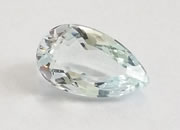 | GosheniteThe colorless to near-colorless variety of beryl is called goshenite. Some of the earliest eyeglasses had lenses made from goshenite because the stone often forms in large, transparent crystals that are free of inclusions. |
| | |
 | HeleniteA man-made glass produced by fusing volcanic ash from the 1980 Mount St. Helens eruption. It is sold in novelty jewelry to tourists visiting the eruption site. |
| | |
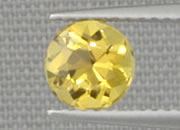 | HeliodorHeliodor is the name given to yellow to yellow-green gems of the beryl mineral group. They can be attractive, durable, high-clarity stones with a relatively low price. Surprisingly, they are infrequently seen in jewelry. |
| | |
 | HematiteHematite is an iron oxide mineral and the primary ore of iron. It occasionally occurs in a silver metallic form that can be polished to a mirror-bright luster. Cabs cut from hematite are very popular and have a very "weighty" feel. |
| | |
 | HemimorphiteHemimorphite is a zinc silicate mineral that occurs in white, blue, and greenish blue colors. It is a minor ore of zinc. It lacks durability and is used as a collector's gem or in jewelry that will be subject to light wear. |
| | |
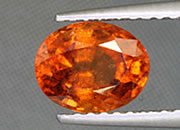 | Hessonite GarnetHessonite is a variety of grossular garnet that is rich in iron and manganese. It has an orange to red-orange to reddish brown color and is sometimes called "cinnamon stone." It is occasionally seen in jewelry. |
| | |
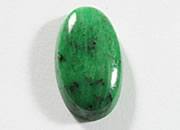 | HydrogrossularHydrogrossular is a garnet in which hydroxide partially replaces silica. Often an opaque green stone, its nickname is "Transvaal jade" because it looks like jade and is found in the Transvaal area of South Africa. |
| | |
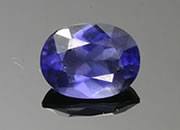 | IoliteIolite is the name given to gem-quality cordierite. It is a strongly pleochroic gem material that, when properly oriented, can produce gemstones with a deep bluish color similar to sapphire and tanzanite. |
| | |
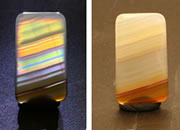 | Iris AgateIris agate is a finely banded agate with a spectacular display of color when it is cut into thin pieces and illuminated from a direction that sends light through its very thin bands. |
| | |
 | JadeAn extremely durable material that has been fashioned into gems, sculptures, tools, and weapons for thousands of years. Extremely popular in China. There are two varieties: jadeite and nephrite. |
| | |
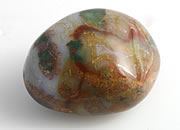 | JaspagateA variety of chalcedony that displays characteristics of both jasper and agate. It has both opaque areas and translucent areas. |
| | |
 | JasperA variety of opaque chalcedony that is often brightly colored by impurity inclusions. It can be almost any color and is popular as beads, cabochons, and tumbled stones. |
| | |
 | JetJet is a coal with a uniform texture that can be cut into attractive black gems. It was popular in mourning jewelry of Victorian England. It has a low specific gravity, which makes a long strand of beads lighter than expected. |
| | |
 | K2K2 and K2 Granite are names used for an azurite granite found at the base of K2, the world's second-highest mountain. It cuts beautiful cabs and polishes to a bright luster. Some people call it K2 Jasper, but that is incorrect. |
| | |
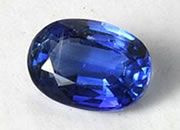 | KyaniteA metamorphic mineral that occurs in beautiful hues of blue and green. It has perfect cleavage and has a hardness of 4.5 in one direction, 5.5 in another, making it best used in items that will not be subjected to wear. |
| | |
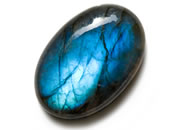 | LabradoriteA gemstone from the plagioclase feldspar family that produces flashes of iridescent blue, green, yellow, orange, or red when moved under incident light. This luster is known as labradorescence. |
| | |
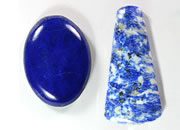 | Lapis LazuliA blue metamorphic rock that has been used as a gemstone for over 6000 years and as a pigment for at least 1000 years. It is a popular gem material used for cabochons, beads, inlay, and small sculptures. |
| | |
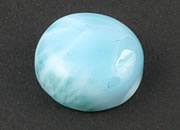 | LarimarLarimar is a rare blue variety of pectolite found only in the Dominican Republic. It is popular because of its delicate blue color. It must be used with care because it is fragile and will fade with long exposure to bright light. |
| | |
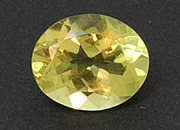 | Lemon QuartzLemon quartz is a yellow variety of quartz that is transparent to translucent. It is often cut as a faceted stone or cut en cabochon. |
| | |
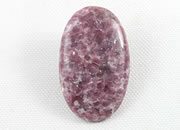 | LepidoliteA lithium-rich mica with a rose to lilac color and an aventurescent luster that is sometimes used to make cabochons, tumbled stones, and other lapidary projects. |
| | |
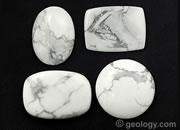 | MagnesiteA magnesium carbonate mineral that is often confused with howlite due to their similar appearance. Magnesite can be easily dyed, and specimens dyed a blue color are used as imitation turquoise. |
| | |
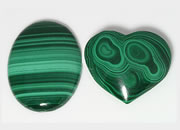 | MalachiteMalachite is a heavy, opaque, green gemstone marked with bands and swirls. It is a copper carbonate mineral that is soft and cleaves easily. It is best used in items that will not be subjected to abrasion or impact. |
| | |
 | Malaya GarnetMalaya is a pink to pinkish brown or reddish variety of garnet. Compositionally, it is a mixture of pyrope, almandine, and spessartine. It is occasionally seen in jewelry. |
| | |
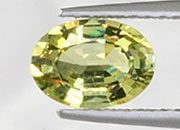 | Mali GarnetMali is a yellow to yellowish green variety of garnet, named after the African country of Mali. It is a mixture of grossular and andradite that is occasionally seen in jewelry. |
| | |
Find Other Topics on Geology.com:
 Rocks: Galleries of igneous, sedimentary and metamorphic rock photos with descriptions. |  Minerals: Information about ore minerals, gem materials and rock-forming minerals. |
 Volcanoes: Articles about volcanoes, volcanic hazards and eruptions past and present. |  Gemstones: Colorful images and articles about diamonds and colored stones. |
 General Geology: Articles about geysers, maars, deltas, rifts, salt domes, water, and much more! |  Geology Store: Hammers, field bags, hand lenses, maps, books, hardness picks, gold pans. |
 |  Diamonds: Learn about the properties of diamond, its many uses, and diamond discoveries. |
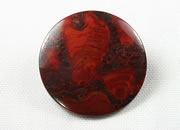 | Mary Ellen JasperMary Ellen is a rock that consists of red jasper and silvery hematite. The jasper is a fossil stromatolite, a layered structure built up by sediment-trapping algae that lived on Earth about two billion years ago - long before land plants. |
| | |
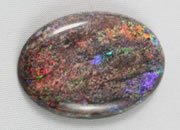 | Matrix OpalMatrix opal is a material in which precious opal is in an intimate mixture with the host rock, instead of being confined to seams and patches. |
| | |
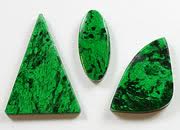 | Maw Sit SitMaw sit sit is a rock composed of jadeite, albite, and kosmochlor (a mineral related to jadeite). It is attractive, has a bright chrome-green color and accepts a bright polish, and for those reasons it is used as a gemstone. |
| | |
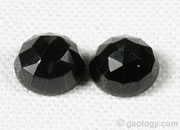 | Melanite GarnetMelanite is a lustrous, black, opaque variety of garnet that is not often seen in jewelry. It is a titanium garnet of the Andradite group and is sometimes called "titanian andradite." |
| | |
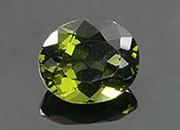 | MoldaviteMoldavite is a glassy material that is thought to have formed when a large asteroid impacted a location in Europe about 15 million years ago. The target rock and impactor melted and solidified into an olive green glass. |
| | |
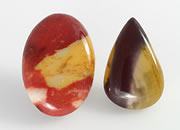 | MookaiteA colorful gem material mined in Australia that forms from the deposition and lithification of a sediment composed of the silica tests of radiolarians. It is a popular material for cabochons and beads. |
| | |
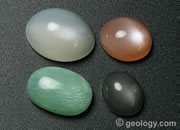 | MoonstoneMoonstone is a name given to translucent orthoclase feldspar that exhibits adularescence (a white-to-bluish light that floats under the surface of the stone when it is turned under a source of light). |
| | |
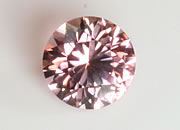 | MorganiteMorganite, also called "pink beryl," is the pink- to salmon-colored gemstone member of the beryl mineral group. |
| | |
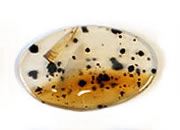 | Moss AgateMoss agate is a transparent-to-translucent chalcedony that contains mineral inclusions that are shaped like moss, trees, leaves, or other vegetation. Material from Montana localities is very popular. |
| | |
 | Mother of PearlMother of pearl, also known as "MOP," is the thin inner nacreous layer of a mollusk shell. It can be white, cream, or gray in color with a beautiful iridescent play-of-color. Used in jewelry, buttons, musical instruments, and more. |
| | |
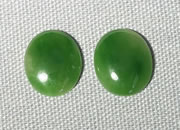 | NephriteNephrite and jadeite are two very similar minerals that are both known as "jade." Nephrite is the more abundant and less valuable mineral of the pair - but it can still have great beauty and appeal. |
| | |
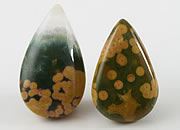 | Ocean JasperA gem material named because it is found below the high tide line of a Madagascar ocean beach. It is patterned with beautiful eyes and bands in a wide variety of colors. It also can grade from agate to jasper in a single stone. |
| | |
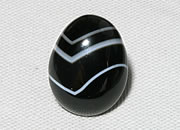 | OnyxOnyx is the name given to a black chalcedony with parallel white banding or a red chalcedony with white banding. High-quality pieces are sometimes used to carve cameos. |
| | |
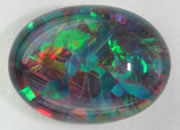 | OpalA spectacular gemstone that produces flashes of iridescent color when moved under incident light. Opal also occurs as nonphenomenal gems with beautiful body color. There are many types of opal. |
| | |
 | Opalized WoodA type of petrified wood that is composed of opal, usually common opal, rather than chalcedony or another mineral material. |
| | |
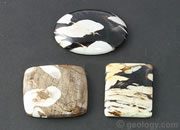 | Peanut WoodA variety of petrified wood from Australia. Some pieces have white markings that remind people of peanuts. It is a fossil driftwood that has been bored by marine clams. |
| | |
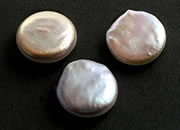 | PearlsPearls are a very popular gem material. They are produced by shellfish, and people have used them for personal adornment for thousands of years. These are cultured freshwater pearls produced in Tennessee. |
| | |
| ADVERTISEMENT | |
| | |
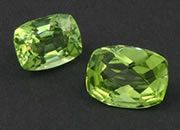 | PeridotPeridot is a popular green gemstone from the olivine mineral series. It is widely used in commercial jewelry and is a birthstone for the month of August. |
| | |
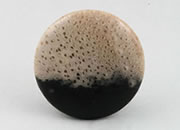 | Petrified PalmLouisiana has been the "bayou state" for over 100 million years. During that history, many palms have been fossilized. Today they are called "petrified palm wood" (but they really are not wood) and polished into beautiful gems. |
| | |
 | Petrified WoodA fossil that is formed when woody material is buried, then dissolved materials in groundwater precipitate to replace and infill the wood structure with silica, opal, or other mineral material. |
| | |
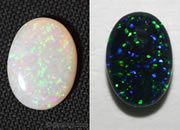 | Pinfire OpalAn opal that exhibits pin points of fire instead of a broad flash is known as "pinfire opal." There are many types of opal. |
| | |
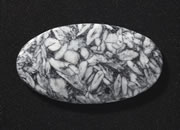 | PinolithPinolith is a metamorphic rock composed of white magnesite crystals on a background of graphite-pigmented dolomite. It is a rare material that is found only in Austria and Spain. |
| | |
 | Polka Dot AgateA beautiful blue to white to yellow translucent agate with lots of colorful dots. It is an American gemstone mined in Oregon. |
| | |
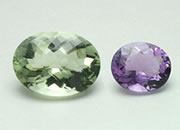 | PrasiolitePrasiolite is amethyst that has been heat-treated to a leek-green color. |
| | |
 | PrehnitePrehnite is a calcium aluminum silicate mineral. Specimens with nice color and clarity are often cut as gems. This gemmy yellow prehnite cabochon was cut from material mined in Australia. |
| | |
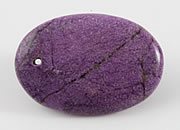 | PurpuritePurpurite is a manganese phosphate mineral with a bold purple color that is often cut into cabochons. It has a low hardness (4 to 5) so is best used in jewelry that is not expected to receive rough wear. |
| | |
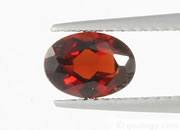 | PyropePyrope is a magnesium aluminum garnet that is usually red in color. It is often formed in the mantle and transported to the surface in deep-source volcanic eruptions that form diamond deposits. |
| | |
 | QuartzQuartz is the most common mineral in Earth's crust and often occurs in colored gem-quality crystals. These include rose quartz, amethyst, smoky quartz, citrine, lemon quartz, and others. |
| | |
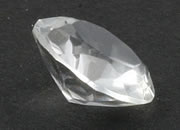 | Quartz, Rock CrystalClear quartz is a common mineral material that is sometimes cut as a gem. It is often called "crystal quartz" or "rock crystal." It is the state mineral of Arkansas. |
| | |
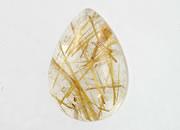 | Quartz (Rutilated)Rare specimens of clear quartz have needle-shaped inclusions of rutile. These can be used to cut interesting and attractive cabochons and faceted stones. |
| | |
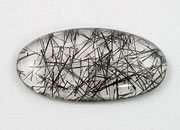 | Quartz (Tourmalinated)Rare specimens of clear quartz have needle-shaped inclusions of tourmaline. These can be used to cut interesting and attractive cabochons and faceted stones. |
| | |
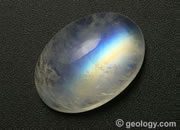 | Rainbow MoonstoneRainbow moonstone is a variety of moonstone that displays an electric blue or multicolor adularescence within a stone of colorless or white bodycolor. |
| | |
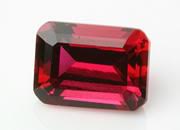 | Red BerylRed beryl is an extremely rare gemstone colored by trace amounts of manganese. It is produced at one location in the world, the Ruby-Violet claims in Beaver County, Utah. |
| | |
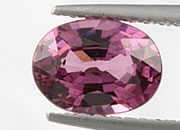 | Rhodolite GarnetRhodolite is a purplish red to violet-red variety of garnet that is a combination of pyrope and almandine. It often has wonderful color and clarity at a relatively low cost - and that is helping it become popular in jewelry. |
| | |
 | RhodochrositeRhodochrosite is a manganese carbonate mineral that is popular because of its beautiful pink color. It typically has lacy or concentric bands. Its softness limits its use to earrings, pendants, pins, and other low-abrasion items. |
| | |
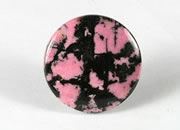 | RhodoniteRhodonite is a manganese mineral that sometimes occurs in a very attractive pink color. Usually translucent to opaque, it is a popular gem material. Rarely, it is transparent and used for faceting. |
| | |
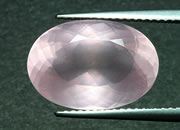 | Rose QuartzRose quartz is a translucent-to-transparent variety of quartz with a light to deep pink color. It is a gem material that is very common in nature. It is usually cut into cabs and occasionally faceted. |
| | |
 | RubyRuby is the most popular colored stone. When the mineral known as corundum is of gem quality and a vivid red color, it is called "ruby." Historically mined in Asia, many rubies such as these are now being found in Africa. |
| | |
 | Ruby in FuchsiteFuchsite is a metamorphic mica with a green color that often contains bright red corundum crystals or "rubies." It is often carved and cut into cabochons. Frequently confused with "ruby in zoisite." |
| | |
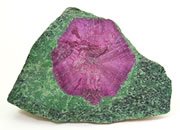 | Ruby in ZoisiteRuby in zoisite is an interesting material. Massive green zoisite often contains bright red ruby crystals. The color combination makes an attractive and unique gem material. It is often cut and carved into small sculptures. |
| | |
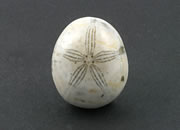 | Sand DollarSand dollars found on beaches today are remains of a group of animals that has lived in the oceans for millions of years. Their bodies are often agatized by nature and then found by people who polish them into gems. |
| | |
 | SapphireSapphire is a gem variety of the mineral corundum. When it is reddish blue to violet-blue, it is known simply as "sapphire." Corundums of any other color (except red, which is ruby) are known as "fancy sapphires." |
| | |
 | Sapphire, StarStar sapphire contains elongated crystals of rutile aligned in three different directions that cause a properly cut stone to display a six-ray star. This phenomenon is known as "asterism." |
| | |
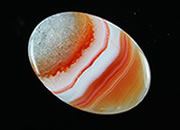 | SardonyxSardonyx is a member of the chalcedony family. It is a banded agate that contains bands of bright red alternating with agate of other colors. |
| | |
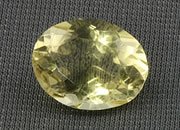 | ScapoliteScapolite is a metamorphic mineral that sometimes occurs in transparent gem-quality crystals that make beautiful faceted gems. Some specimens contain a silk that can produce a strong cat's-eye. |
| | |
 | Scapolite (Cat's-Eye)Cat's-eye scapolite is a gem-quality scapolite with a silk of parallel mineral fibers. When cut as a cabochon, light striking the stone reflects from the mineral silk to produce an "eye" that moves across the stone. |
| | |
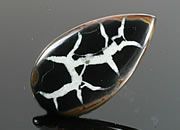 | Septarian"Septarian" is a name used for round concretions with internal mineral-filled fractures found in sedimentary rocks. They are often cut into cabochons that display the interesting geometry of the fracture network. |
| | |
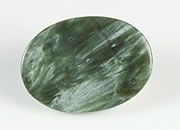 | SeraphiniteSeraphinite is a trade name used for a gem material composed of the mineral clinochlore. It is usually greenish in color and marked with fibrous or feather-like patterns. Its hardness is only 3 to 4 and is reserved for delicate use. |
| | |
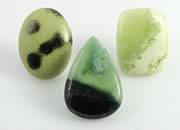 | SerpentineA silicate mineral that occurs in a wide range of green and greenish colors with interesting patterns. Serpentine is often cut into cabochons or used as an ornamental stone. |
| | |
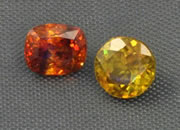 | SideriteSiderite is an iron carbonate mineral with a very high dispersion. Transparent crystals of siderite with great clarity can be cut into attractive gemstones with a strong fire. It is too soft for most jewelry and is a collector's stone. |
| | |
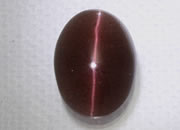 | Sillimanite (Cat's-Eye)Sillimanite is a metamorphic mineral that often has a fine fibrous silk. When properly cut, cabochons of the material can reflect a sharp cat's-eye. |
| | |
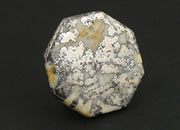 | Silver OreSilver is a precious metal that is often present as visible crystals in its ore. Some people enjoy seeing the bright metal reflecting from the surface of a cabochon. It is a novelty gem. |
| | |
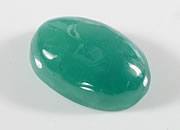 | SmithsoniteSmithsonite is a zinc carbonate mineral that serves as a minor ore of zinc and as a minor gem mineral. It is relatively soft and used as a collector's gem and in jewelry that is unlikely to receive abrasion or impact. |
| | |
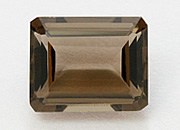 | Smoky QuartzSmoky quartz is a grayish brown to nearly black variety of transparent quartz. It is often cut as a faceted stone or cabochon. Upon heating, it will sometimes change in color to yellow or yellowish brown citrine. |
| | |
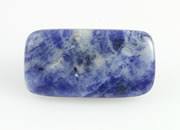 | SodaliteA feldspathoid mineral that ranges in color from white to blue to violet blue. It is often used to make cabochons, tumbled stones, and other lapidary projects. |
| | |
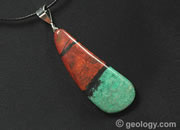 | Sonora SunriseSonora Sunrise is a trade name for an eye-catching red and green gem material. It occurs naturally as a rock composed mainly of bluish-green chrysocolla and bright red cuprite. |
| | |
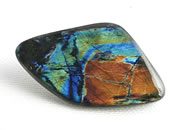 | SpectroliteSome specimens of gem-quality labradorite have exceptional color and labradorescence. These unusual gems are given the name "spectrolite" because of the spectrum of colors that they reflect. |
| | |
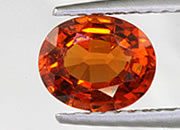 | Spessartine GarnetSpessartine is also known as "spessartite" or as "mandarin garnet" because of its yellow-orange to orange-red color. It is a popular variety of garnet used in jewelry. |
| | |
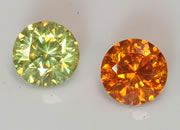 | SphaleriteWith a dispersion that is 3x that of diamond, sphalerite can be a very attractive faceted stone. It is popular with collectors but has very limited jewelry use because of its very low hardness (3.5 to 4) and perfect cleavage. |
| | |
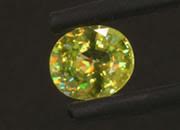 | SpheneSphene, also known as titanite, is a gem with a dispersion higher than diamond. Specimens of high clarity can be cut into gems with a brilliant fire. Its softness limits its use to earrings, pins, pendants, and low-abrasion jewelry pieces. |
| | |
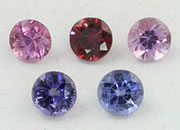 | SpinelA mineral of many colors that has been treasured as a gem for thousands of years. It was often confused with ruby and sapphire. Many of these errors were not discovered until the 20th century. |
| | |
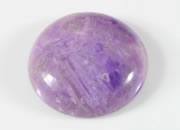 | SugiliteSugilite is a rare silicate mineral only discovered in 1944. It occurs in yellow, brown, pink, and purple and is often combined with quartz. The purple color has become very popular in the lapidary trade. Its high price limits its popularity. |
| | |
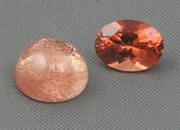 | SunstoneA plagioclase feldspar that can be a colorful transparent gem. It can also contain plate-shaped copper inclusions that produce an aventurescent flash when moved under incident light. These specimens are from Oregon. |
| | |
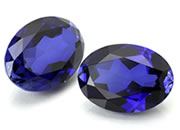 | TanzaniteTanzanite is a rare and popular blue variety of zoisite produced from a small location in the African country of Tanzania. It is a birthstone for the month of December and is an alternative stone for blue sapphire. |
| | |
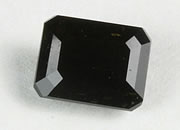 | TektiteTektites are fragments of ejecta produced when an asteroid struck Earth about 800,000 years ago. The impact melted the target rock and scattered a black glass in a strewn field across southeastern Asia. |
| | |
 | ThuliteThulite is a rare, pink, gem-quality variety of zoisite. It can be cut into beautiful cabochons, beads, small sculptures, and other lapidary items. |
| | |
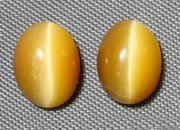 | Tiger's-EyeTiger's-eye is a material that forms when quartz replaces crocidolite. When it is cut into a cabochon with its fibrous structure parallel to the bottom of the stone, a chatoyance, or cat's-eye effect, is produced. |
| | |
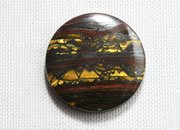 | Tiger IronTiger iron is a rock composed of alternating bands of silver hematite, gold tiger's-eye, and red jasper. It is cut into attractive and interesting cabochons, beads, spheres, and other lapidary items. |
| | |
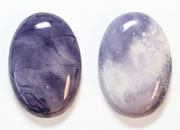 | Tiffany StoneAlso known as "bertrandite," Tiffany stone is a beautiful material that is thought to be an opalized fluorite. Found at one beryllium mine site in Utah. |
| | |
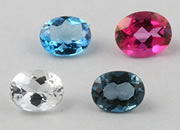 | TopazTopaz is a popular gem. It is usually clear to amber in color when mined. It can be heated, coated, or irradiated to produce other colors that include "Swiss blue," "London blue," bright pink, and soft pink. |
| | |
 | TourmalineTourmaline is a silicate mineral that occurs in a wide range of attractive colors. It is a very durable gem material that is popular with jewelry makers. |
| | |
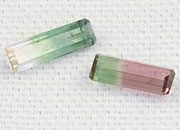 | Tourmaline (Bicolor)When tourmaline crystals grow, the composition of their growth fluid can change. Color-zoned crystals might be the result. These crystals can be cut into interesting bicolor stones. Some are known as watermelon. :-) |
| | |
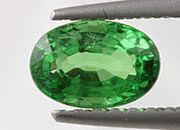 | Tsavorite GarnetTsavorite is a calcium-rich garnet known for its brilliant green color. It sometimes serves as an alternative stone to emerald. It is the most important green garnet and one of the rarest and most valuable colored stones. |
| | |
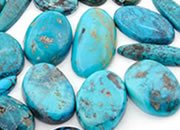 | TurquoiseA copper mineral with a bright blue to blue-green color. The color is so familiar and liked that the word "turquoise" is used in the English language as the name of a color. Only a few gems have a color this familiar. |
| | |
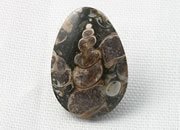 | Turritella AgateDecades ago, this agate was named "Turritella" after the fossil snails that it contains. That name is incorrect because the snails were misidentified. The proper name should be "Elimia agate" after the snail Elimia tenera. |
| | |
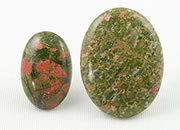 | UnakiteUnakite is an igneous rock that contains green epidote and pink orthoclase feldspar. It can be coarse or fine grained. It is popular as cabochons, beads, and small sculptures. |
| | |
 | VarisciteA mineral that is similar to turquoise in mode of formation and composition. It even looks like turquoise but in a blue-green to yellowish green color. Cut into cabochons, but its use is limited because it is soft (H: 4.5). |
| | |
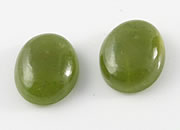 | VesuvianiteVesuvianite is a mineral formed by the contact metamorphism of limestone. It is often an attractive translucent green color that reminds people of jade. Rare transparent crystals are faceted. Named after Mt. Vesuvius. |
| | |
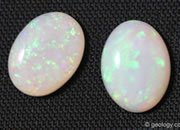 | White Opal"Light opal" or "white opal" are terms used for an opal material with a white, yellow, or cream-colored body color. This is the most common body color for precious opal. There are many types of opal. |
| | |
 | ZirconZircon is a hard, durable gem that occurs in a variety of colors. Its brightness and fire rivals those of diamond. Colorless zircon was once used as a popular and fraudulent alternative to diamond. |
| | |
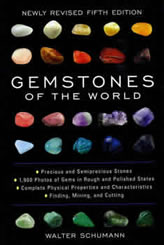 | Gemstones of the WorldWe highly recommend Gemstones of the World by Walter Schumann. It is one of the most popular gemstone books ever written, with over one million copies sold. It has about 100 pages of basic gemstone information and about 200 pages dedicated to photos and descriptions of over 100 gems and gem materials. It is a well-illustrated book for the beginner and contains essential reference material for anyone with an interest in gems. |
| | |
Different Color Gems Silver Jewelry Picture
Source: https://geology.com/gemstones/gems/